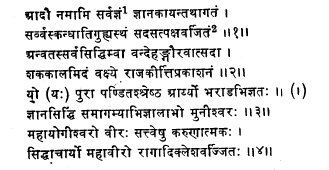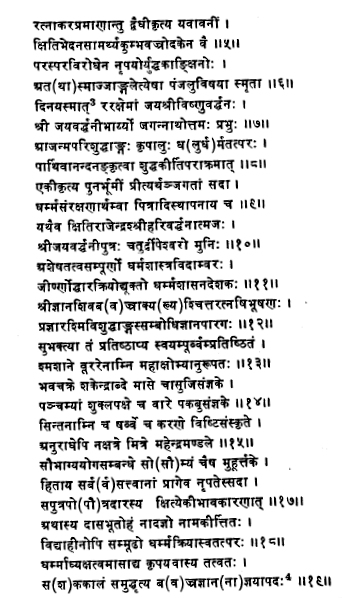Materials for the Medieval History of Indonesia
1289.09.21.


1. First of all I revere the Tathagata, the omniscient and the embodiment of all knowledge, who lies hidden in all the elements (skandhas) and who is devoid of association with things existing or non-existent.
2. Next do I honour, respectfully, the universal success und shall (then) narrate (the following history connected with) the Saka era describing the glory of kings.
3. The venerable Bharad, the lord amongst sages and the best of learned men, who, in ancient times, through his experience, obtained (perfection in) knowledge and thus acquired the supernatural faculties (abhijna).(1)
4. Who was the lord of the great yogins, calm and compassionate towards living beings, who was a Siddha teacher, a great hero and who was devoid of the stains of attachment, etc.
5-6. Who divided into two the land of Java which was as extensive as the sea, by means of the water pot (kumbha), vajra and water(2) (?) which had the power of breaking up the earth and (gave them to) the two princes who, out of hostility, were bent on strife - therefore this Jangala is known as the Pamjalu vishaya.
7-9. But, hereafter the lord Jayasrivisnuvardhana - who had as his spouse Sri Jayavardhani, who was the best among the rulers of the earth, who was pure in body from his (very) birth, who was compassionate and exclusively devoted to the Law, who caused delight to (other) rulers through his pure fame and valour - again united this land to the delight of the people in order to maintain the Law and to establish(3) his ancestors and ruled it (with justice).
10-12. The sage of a king named Sri Jnanasivavajra, the son of Sri Harivardhana and Sri Jayavardhani, was the lord of the four islands, was full of boundless knowledge, was the best of those knowing the Law and was the instructor in the code of laws, whose mind was his jewel-ornament and who was eager to do the work of repairing (religious institutions), whose body was purified by the rays of wisdom and who was fully versed in the knowledge of sambodhi - was like Indra among the rulers of the earth.
13-17. Having set up with due devotion the statue of him (i.e., the king ?) who was already consecrated (as such ?) in the shape of Mahakshobhya, in the year 1211 of the Saka era in the month of Asuji (Asvina), on the day known as Pa-ka-bu, the fifth day of the bright half (of the month), in the parvan named Sinta and the karana vishti, when the nakshatra Anuradha was in the orb of Indra, during Saubhagya yoga and Saumya muhurta and in Tula rasi - for the good of all beings, and foremost of all, for that of the king with his wife, son and grandson, owing to his bringing about the union of the kingdom.
18-19. I, his (i.e. king's) humble servant, who is known by the name of Nadajna, and though ignorant, devoid of learning and little inclined to pious deeds, was made through his grace alone the superintendent of religious rites, have prepared this description by order of Vajrajnana (?).(4)
(2)
The sense of vajra
- and how the division came about - is not clear.
(3) Sthapana
probably refers to erecting (an image), maybe of ancestors.
(4)
Translation only coniectural.
first draft, not proofread /